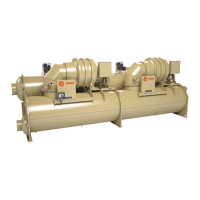CDHH-SVX003C-EN
75
CWR – Outdoor Option
The outdoor temperature sensor is similar to the unit-
mounted temperature sensors in that it consists of the
sensor probe and the module. A four-wire inter-processor
communication (IPC) bus is connected to the module for
24 Vdc power and the communications link. Trane
recommends mounting the sensor module within the
control panel and the sensor two wire leads be extended
and routed to the outdoor temperature sensor probe
sensing location. This ensures the four-wire inter-processor
control (IPC) bus protection and provides access to the
module for configuration at start-up.
The sensor probe lead wire between the sensor probe and
the module can be separated by cutting the two-wire probe
lead leaving equal lengths of wire on each device: the
sensor probe and the sensor module.
Note: This sensor and module are matched and must
remain together or inaccuracy may occur.
These wires can then be spliced with two 14 to 18 AWG
600V wires of sufficient length to reach the desired outdoor
location with a maximum length 1000 ft (304.8 m). For
AWG/MCM equivalents in mm
2
, refer to the table in
“Electrical Requirements,” p. 53. The module four-wire bus
must be connected to the control panel four-wire bus using
the Trane-approved connectors provided.
The sensor will be configured (given its identity and
become functional) at start-up when the Trane service
technician performs the start-up configuration. It will NOT
be operational until that time.
Note: If shielded cable is used to extend the sensor leads,
be sure to cover the shield wire with tape at the
junction box and ground it at the control panel. If the
added length is run in conduit, do NOT run them in
the same conduit with other circuits carrying 30 or
more volts.
Important: Maintain at least 6 in. (15.24 cm) between low-
voltage (less than 30V) and high voltage
circuits. Failure to do so could result in
electrical noise that may distort the signals
carried by the low-voltage wiring, including the
IPC.
Optional Control and Output Circuits
Install various optional wiring as required by the owner’s
specifications (refer to “System Control Circuit Wiring (Field
Wiring),” p. 70).
Starter Module Configuration
The starter module configuration settings will be checked
(and configured for remote starters) during start-up
commissioning.
Note: To configure starter modules and perform other
starter checks, it is recommended that the line
voltage three-phase power be turned off and
secured (locked out), and then that a separate
source control power (115 Vac) be utilized to power
up the control circuits. This needs to be done in
each panel.
Use the as-built starter schematic to ensure correct fuse
and terminals. Verify that the correct fuse is removed and
that the control circuit connections are correct; then apply
the 115 Vac separate source power to service the controls.
Schematic Wiring Drawings
Please refer to the submittals and drawings that shipped
with the unit. Additional wiring drawings for CenTraVac™
chillers are available from your local Trane office.
System Control Circuit Wiring (Field Wiring)

